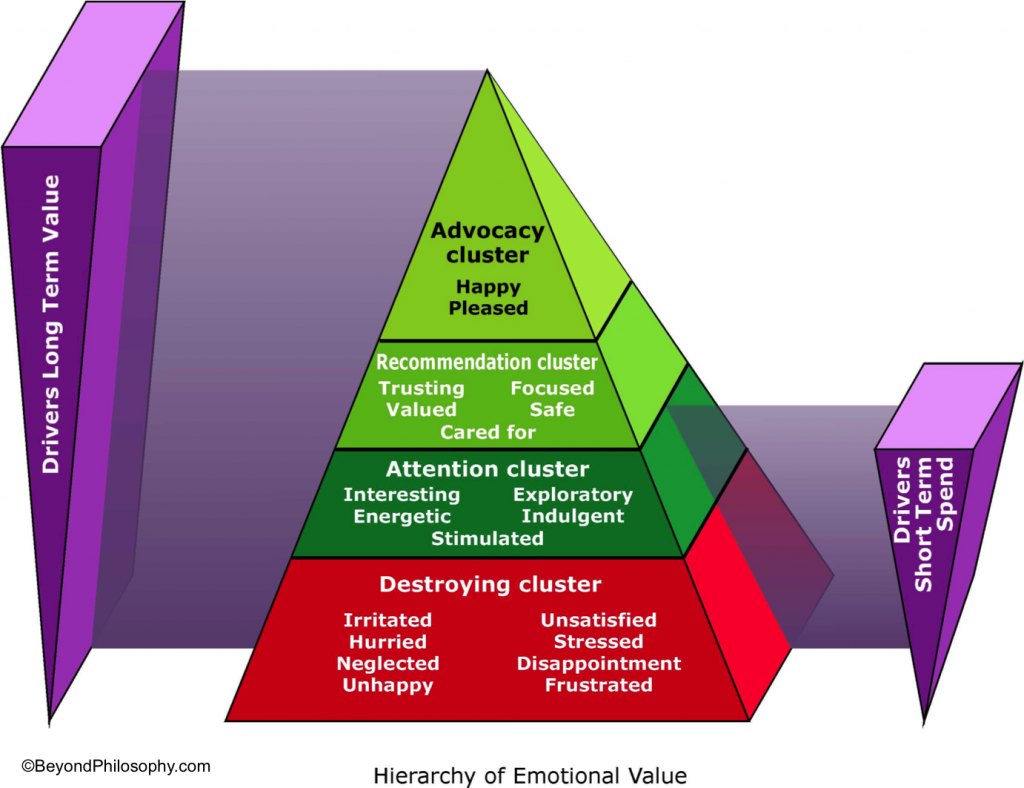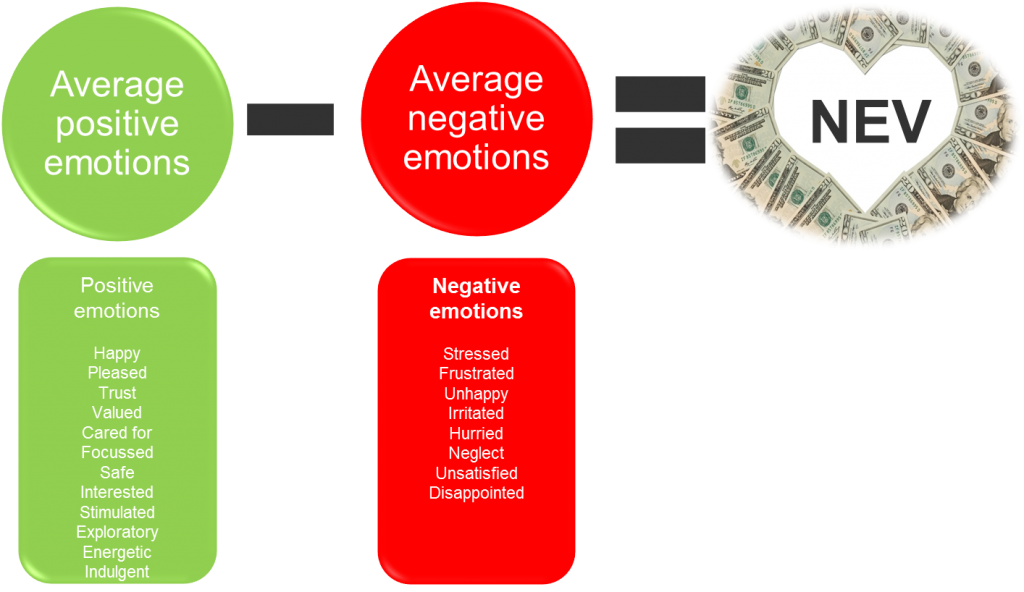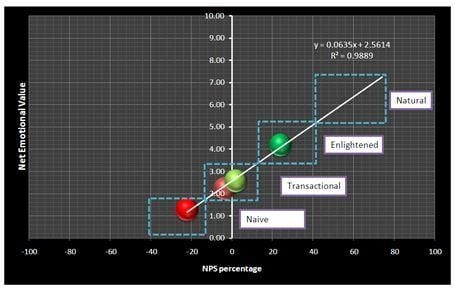People do not just make decisions rationally. Human decision-making is complex and how we feel greatly influences what we do and thus what Customers buy. How can we measure Emotional Value? Just as Net promoter determines the level of a person to recommend to your organization so ‘Net Emotional Value’ measures the level of emotional value. Our statistical analysis shows there is a direct correlation between the two. This article outlines this in more detail.
Net Emotional Value
What drives value for your organization? Are all the factors that drive value purely rational, e.g. price, quality, speed of delivery, etc? The answer is no. People are complex animals and our decision making process is far more complex than that. Human beings are not just robots that are driven by logic, far from it. People make decisions through complex constructs which are only just being understood. One thing that everyone agrees with is that people are, in fact, irrational. How many times do you press the button waiting for an elevator, we all know it won’t come any faster but we somehow feel better having done it! This is not the behavior of a rational being. The combination of this irrationality and how and why people do things is now the subject of extensive writings on Behavioral Economics.
What everyone agrees is value is not just rational. For example, look at your watch. Is your watch a $2 watch from the local gas station or is it something that is more attractive and potentially even branded? In an extreme case you may be the proud owner of a Rolex. Both the Rolex and the gas station watch perform the same function, they tell the time, but the ‘value’ that people put on a Rolex is much higher than one purchased in a gas station and this is apart from the actual price paid. Thus there is ‘emotional value’ and this can be intangible and hidden. Some people can recognize it, others can’t. It’s just a feeling, but a feeling that drives our actions.
Value is made up of rational and emotional value. An example of rational value would be if I decided to do the calculation of how much longer the Rolex watch would last than the gas station watch. I maybe question how many gas station watches I would need to buy to equate to the cost of a Rolex? This is rational value. Another example is that of auto parts. Ford parts are less expensive than a Jaguar and therefore, over time, I can calculate the cost of the parts I am likely to spend. That is rational value.
Emotional value is much more intangible. Emotional value is more about me as a person. How much value do I place owning a Jaguar against a Ford? The feeling I get being part of the ‘club’ that owns Jaguars, the history of the brand and the value I place on people admiring my car, the value on being able to accelerate at 0-60 in X seconds – this is more emotional value.
Emotional value is hard to define. Emotional value is also not just about the brand. Emotional value can be the value I place on having local stores. As an example, I like to go fishing at weekends. I like my local tackle shop. They are more expensive than Wal-Mart but I am willing to pay that to get the advice I receive at my local store; in fact I have to drive past two Wal-Marts to get there! Why do I do this, what do I value? I value the fact they know me which makes me feel ‘valued’. They are friendly. We always have a joke about my wife, Lorraine, and how she hates going in there and me spending my money on fishing tackle! Because of these things, and more, I have formed an emotional attachment with them. As a consequence I am prepared to pay more. I feel a loyalty towards them and would feel guilty, genuinely guilty, if I bought something elsewhere.
Therefore, Customers feel emotions and these provide a ‘value’ to them. They drive their buying decisions. If you are in a business the next question you will ask is how much value will I gain from improving the customer experience? Which emotions drive most value for the organization and how do we measure it?
In the past, the Net Promoter Score (NPS) has been the best way to measure the loyalty of customer relationships to a particular business. First introduced in 2003, it was an innovation and improvement on customer satisfaction research. Implementations of NPS have tended to focus on the rational aspects of an experience not the emotional side. This is partly because Customers do not always mention how they feel, however over 50% of a Customer Experience is about how a Customer feels.
Most businesses ignore this half because they don’t know how to measure it. How can we take this to the next level and give businesses the tool to measure the irrational parts of the customer experience (emotional and subconscious influences) that play such an important role in loyalty? The answer is by including emotional value as well and rational value. Let me explain.
In my book on this subject, The DNA of Customer Experience: How emotions drive value – Palgrave McMillan, Shaw 2007, I outlined our two years of research with the London Business School. This work was also checked by the Chair of Consumer Psychology in England and all the emotions outlined are based on their official definitions. This work proved which emotions drive and destroy most value for organizations. The output of this can be seen in Figure 1.

You will see at the bottom there are 8 emotions that are proven to destroy value. This is the Destroying Cluster.
Next up the hierarchy is the attention cluster of emotions. These are proven to drive short term value. You will note these are effectively what the marketing department works on. They try to ‘stimulate’ Customers and make them want to ‘explore’ their offers.
We then get into the recommendation cluster. These are emotions that are proven to drive people to stay with an organization longer.
Finally, we have the advocacy emotions. These were called the ‘Big Daddy’ by the statisticians. These are emotions that are at the top of the hierarchy. If you can get your customers to feel these emotions they then drive the most value for an organization.
Since 2005 we have surveyed nearly 35,000 people across multiple countries, in many industries. We have asked approximately 2.5 million survey questions with 1 million of those questions being about how a customer feels. We draw our conclusions from this data. In a recent review of this data we have discovered what we call…
‘Net Emotional Value (NEV)’
Our statistical evidence proves that if you take the positive emotions from your negative emotions you get to a Net Emotional Value. NEV drives Net Promoter Score (NPS). NEV is a single number that represents your emotional value to customers. The bigger the number, the more loyal relationships a business has. Or to restate it, the higher the NEV score then the higher the NPS score.
The beauty of NEV is that it represents the overall balance of how your Customers feel about you and thus what drives value. This is the ‘net’ effect of the emotions they feel. Why ‘Net’ emotions? Quite simply, in an experience a Customer may feel a number of emotions, some good, some bad. For example you may feel that a hotel is difficult to find, the car park is small and you feel frustrated. However, the reception staff was very attentive and when you interact with the bartender she was very engaging. You experience different emotions through your Customer journey, so you make an overall judgment and you have a ‘net emotion’ that you feel which takes into account the highs and lows. This is the Net Emotional Value. NEV takes into account a number of emotions you feel, both positive and negative and provides one overall number; your Net Emotional Value (NEV). The beauty of NEV is that it’s very simple, like NPS.
An organization’s Net Emotional Value is a very simple calculation. NEV takes the average of the emotions from our book, The DNA of Customer Experience: How Emotions Drive Value, which are from Fig 1:
- Positive emotions: Happy, Pleased, Trusting, Valued, Cared for, Safe, Focused, Indulgent, Stimulated, Exploratory, Interested, Energetic.
- Negative emotions: Dissatisfied, Frustrated, Disappointed, Irritated, Stressed, Unhappy, Neglected, Hurried.

Our work also shows that the higher the Net Emotional Value, the higher the Net Promoter Score.

Figure 1 shows there is an emotional foundation in Net Promoter and Customer Satisfaction. Figure 3 shows the relationship between the profiles and the Net Promoter® percentages forming a linear relationship between NPS percentages and NEV scores.
We have overlaid our Customer Centricity model called ‘Naïve to Natural’ in an attempt to explain what is happening with these organizations. A very quick explanation of how organizations fit into these four categories of how Customer Centric an organization is:
- Naïve organizations are like the classic thought of a ‘used car dealer’ where you buy the car and the engine falls out, but they do not care. These types of organizations are just focused on themselves to the detriment of the Customer. They ignore the emotional experience. Think of Ryanair in the UK or monopoly utilities companies.
- Transactional organizations are the majority of organizations. They tend to treat Customers as transactions and therefore have a low emotional engagement. Telecoms companies, Cable TV and banks very much epitomize these organizations.
- Enlightened organizations have recognized that emotions drive value and focus on delivering an emotionally engaging experience. Think of Ritz Carlton, Starbucks.
- Natural companies have a natural focus on the Customer and look at the complete Customer Experience. They look at the emotional and rational experience. These are the Disney’s and Harley Davidson’s of the world.
Net Emotional Value and its relationship to Customer Satisfaction
As we can see from Figure 4 below, the relationship between the NEV profiles and customer satisfaction again is linear. The relationship is less apparent than for Net Promoter® but nonetheless demonstrates continuity between growth in customer satisfaction and Net Emotional Value.

So what does this all mean and what should you do? Many organizations have implemented the Net Promoter Score (NPS). A number of organizations are now reaching the point where their NPS is plateauing. NEV and realizing Customer emotions is the next step to driving further value for your Customer Experience. One of our clients, Maersk Line, the largest shipping company in the world, along with our help implemented a large program that focused on improving their Customer Experience. In a case study independently published by Forrester they showed they increased their loyalty score by 40 points in 30 months and that had a 10% increase in shipping volumes. So this is not just a theory it works in reality.
I would advocate that you take the following steps. Firstly, before you do anything I would suggest that you need to measure what your organization’s NEV score is. How do you do this? Simply ask your customers how they feel against the emotions we have outlined. Clearly you can do the same with your competition.
The next step would be to determine which emotions drive most value for you. Which emotions are going to differentiate you in the market. We use a special form or research called an Emotional Signature® for this work as it shows the $$$ that will be generated by each emotion. When you have this I would then recommend that you have a strategic discussion with your CEO and C-suite execs to define the emotions you will be focusing on evoking.
There are clearly many implications to the organization for evoking certain emotions. For example, if you are trying to make your Customers feel ‘cared for’ then operating a measurement structure in your call center that focuses agents to cut calls short with customers is not a good idea. Therefore if you selected ‘cared for’ as a key emotion then this would need to change. When you have decided on these emotions the next step is to design these emotions into your experience design. There are key things that your should do to make your customers feel ‘cared for’. Listening to them would be a good start. Employing empathic people would be a good second step. The list becomes endless.
In summary, value is not just rational value. Value is emotional value as well. This means that you have to decide which emotion will drive most value for you, make a start and then measure the value you are creating through Net Emotional Value.




Enjoyed the article.
Are all emotions negative or positive though? Is this really a binary classification?
e.g. I found this article “challenging” – that could be both positive (broadening my mind) or negative (too hard to understand clearly). Or neither (I’m simply conscious of the emotional effort).
If some emotions are neutral, then do they get a neutral score? Does that do justice to them?
PS: I think the title of your post should be complement NPS, not compliment (unless you’re just trying to be nice to it!!)
Thank you
very interesting article , but all of people could have différents kinds of the NEV because almost a day for month es différents for the biorythme , but is important for the organization made very good préparation for the customer assistant , but also the measure with NPS this is good for find the score every person , my question will be
1.- The CRM give some help for the organization ?
2.- If the Date Mining give plus enlightening for the best service to the customer ?
Best regard
Oscar Sanchez
Thanks!
I didn’t know the NEV. Interesting to see the comparison with the NPS.
We currently use another indicator developed by a startup cxinsights.io co-founded by 2 cognitive psychology scientist. They calculated the emotional index based on the detected emotion in customer comments (every emotion has a dedicated score that is averaged).
The correlation between CSAT and NPS have been well demonstrated in our daily use case.